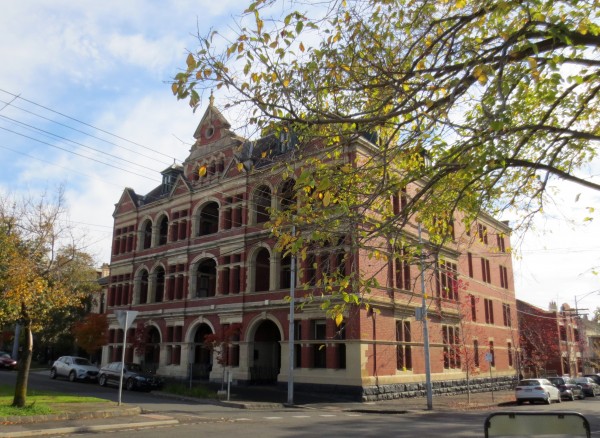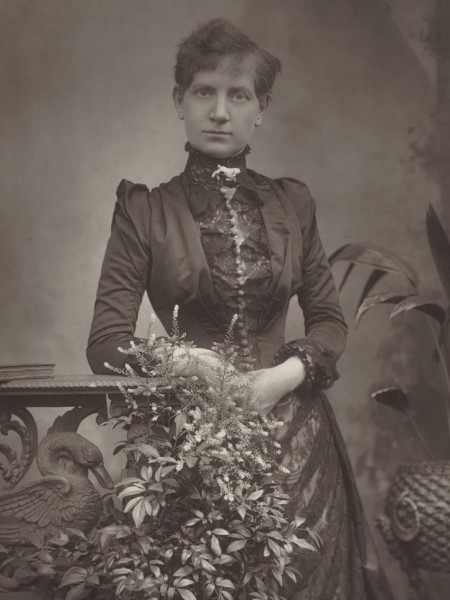Queen Bess Row and Madam Midas
Queen Bess Row, 72-76 Hotham Street, is possibly East Melbourne’s most remarked upon building. Its three red-brick, four-storey houses exhibit a rich decorative scheme of gables and arches which single it out among the smaller and more conservative houses around it.
The notice of intention to build three houses lodged with the Council in December 1886 showed that the architects were to be Tappin, Gilbert and Dennehy and that the owner was a ‘Miss Cornwall’. For a long time a mystery woman, Miss Cornwall has recently been identified as Alice Cornwell, also known as Madam Midas, the same Madam Midas whose life gave birth to Fergus Hume’s novel of the same name (1888).
Alice was born in England and arrived here in 1853 as a 1-year-old with her parents, George and Jemima. George was a builder and responsible for a number of Melbourne’s early buildings, Melbourne Grammar School among them. The family moved to New Zealand ten years later, where George worked with the railways. Back in Melbourne, Alice began writing and publishing songs, with little success. In 1875 she married John Whiteman, a blacksmith turned poet and auctioneer as well as Emerald Hill councillor and mayor, and MLA. They had one son, but Alice soon left the marriage, reverting to her maiden name.
In 1881 George Cornwell was one of a group of speculators that leased 6000 acres of land in the Dowling Forest, near Ballarat. The business of the Dowling Forest Estate Gold Mining Company, with George Cornwell as chairman of directors, was to float mining companies or invite tenders to mine portions of the land. One of the companies floated was the Midas Gold Mining Company. In August 1887, miners working for the company unearthed a massive nugget weighing 617 oz. (17.49 kg). Named the ‘Lady Loch’ after the governor’s wife, a legend quickly grew that it was Alice who had advised the miners to dig at the spot where the nugget was found, leading to her becoming known as ‘Madam Midas’.
The months prior to this extraordinary find had been busy for Alice. She had moved into East Melbourne and was living on the corner of Powlett and Gipps Street, in a house she named Midassia. It was originally the home of JJ Clark, architect of Melbourne’s Old Treasury. She was there only a short time, but it is significant that, while living there, she began the construction of Queen Bess Row.
In July 1887 Alice showed a visiting journalist named Phil Robinson around the Midas mine. A friendship evolved and a few months later when she was in London to launch the Midas Mining Company on the English Stock Exchange, Alice bought the Sunday Times and appointed Phil as its editor. She herself wrote a regular column on mining and investment.
But back to Queen Bess Row: The Bairnsdale Advertiser and Tambo and Omeo Chronicle of 23 February 1888 confirmed Miss Cornwall and Alice Cornwell to be one and the same,
So the doux yeux and business tact of that most successful of all Victorian ladies, Miss Alice Cornwell (Mrs. Whiteman), have succeeded in placing the Midas claim in London for £180,000, and coincidently therewith Miss Cornwell’s splendid terrace in East Melbourne, which rivals Sir William Clarke’s mansion, is just completed.
Four months later a prospectus was advertised in The Herald for the float of the East Melbourne Coffee Palace Company Limited. Money raised would go to the purchase of the building to be used as a temperance hotel, with George Cornwell as a prospective director. A lengthy description of the building talks glowingly of its Elizabethan style, its Northcote bricks and its Waurn Pond freestone. All principal rooms were said to have elaborate leadlight windows ‘executed by one of the leading artists of Melbourne’. The number of apartments was thought to be ‘about 84’ and there were nine bathrooms. (‘Apartments’ here surely means ‘rooms’.)
As the prospectus pointed out, the opening of the coffee palace would coincide with Melbourne’s International Exhibition and there would be plenty of visitors requiring accommodation. Unfortunately, the company failed to find a sufficient number of investors and Queen Bess Row never became a coffee palace.
It was placed on the rental market and Miss Henrietta Macartney, trained nurse and daughter of the first Dean of Melbourne, took it on as a private hospital specialising in hydrotherapy. The hospital lasted until 1894. Then the openings between the houses were closed up and the property was leased as boarding houses. In 1990, amid much controversy over the loss of cheap housing, the houses were subdivided and sold as individual private homes.
Although Miss Cornwell appeared as the owner of the land on which Queen Bess Row was built, the purchase was never completed. When the coffee palace scheme failed, the land reverted to its former owner, Joseph Clarke, brother of Sir William Clarke, and Alice apparently walked away with nothing to show for her efforts. It was a small blip in her rise to international fame as mining magnate and businesswoman. Then came the bank crash and Alice’s run ended. In 1894 she married Phil Robinson and went on to found the Ladies’ Kennel Association, spending the rest of her years breeding pug dogs. She died in 1932 at her home in Hove, England. In the end, her greatest legacy is Queen Bess Row.
* This article was first published in the Inner City News of December 2021


